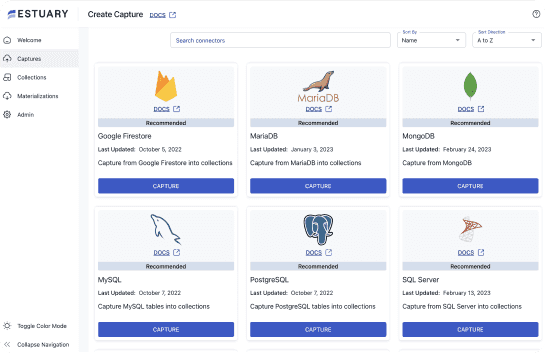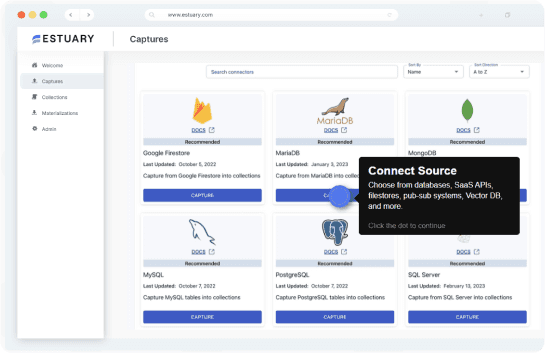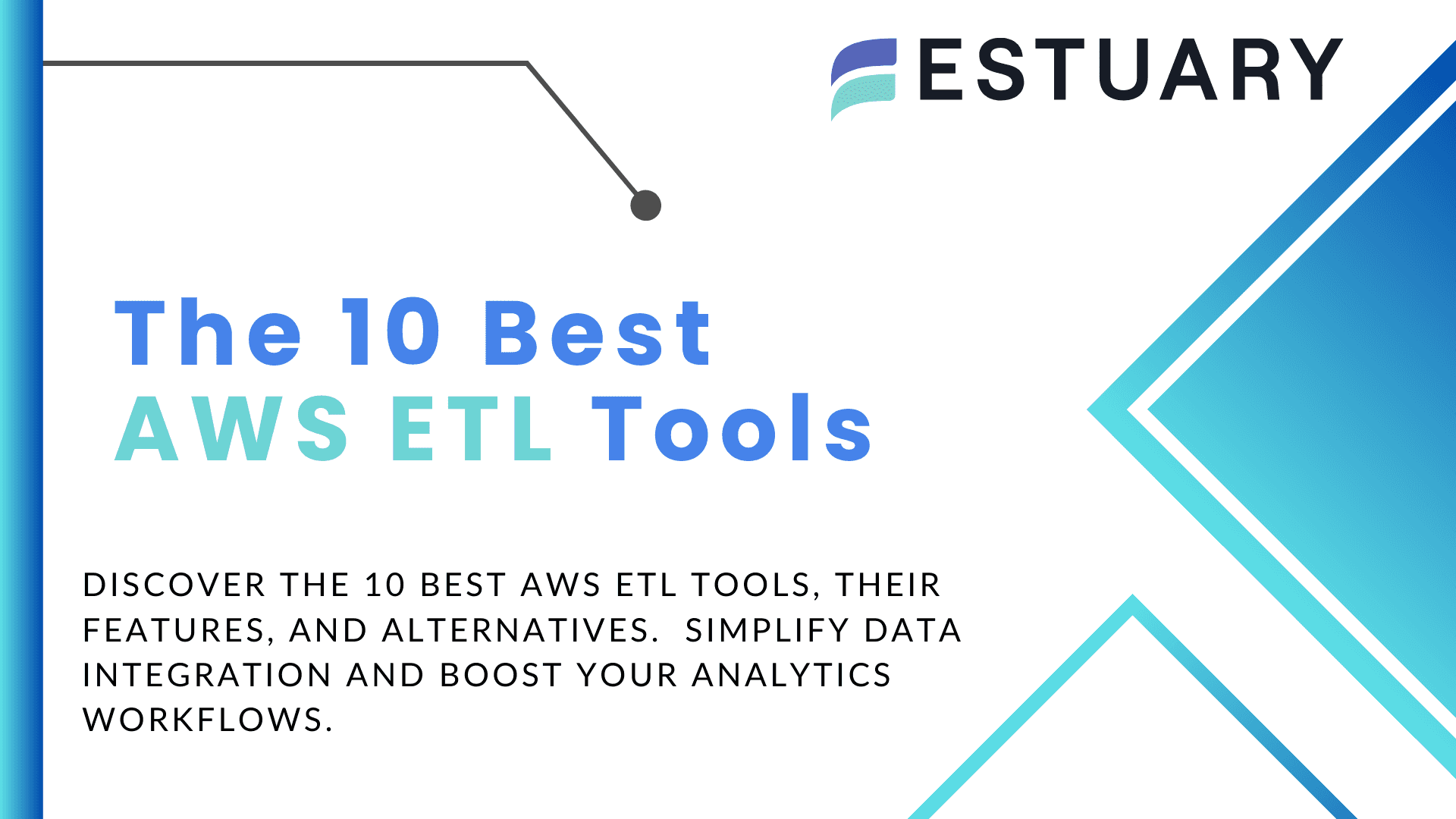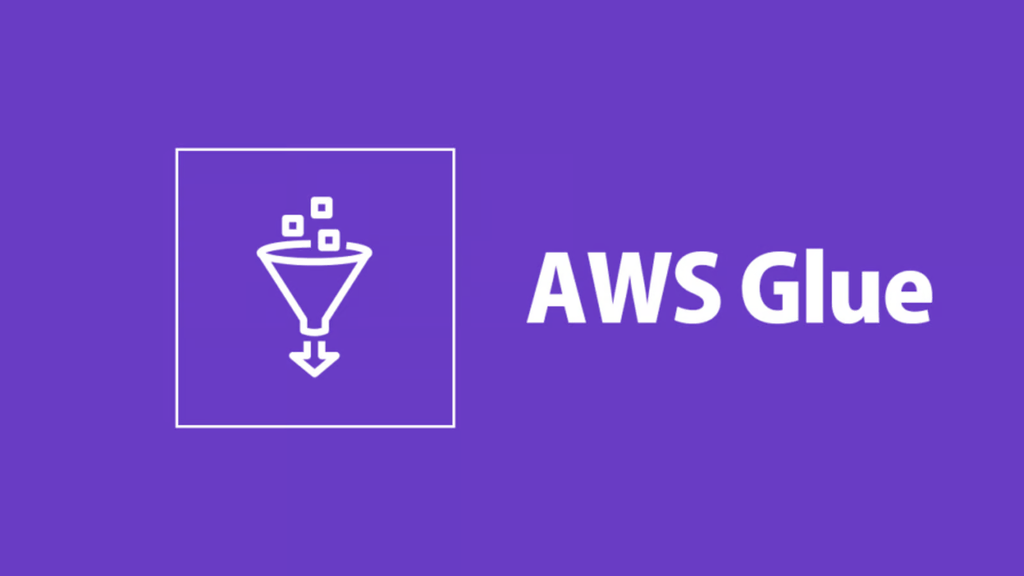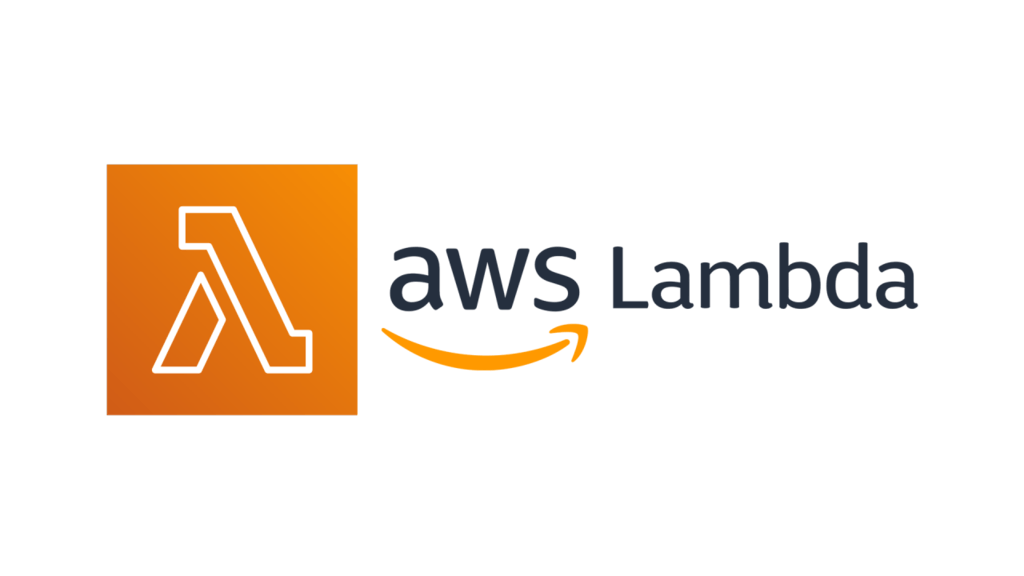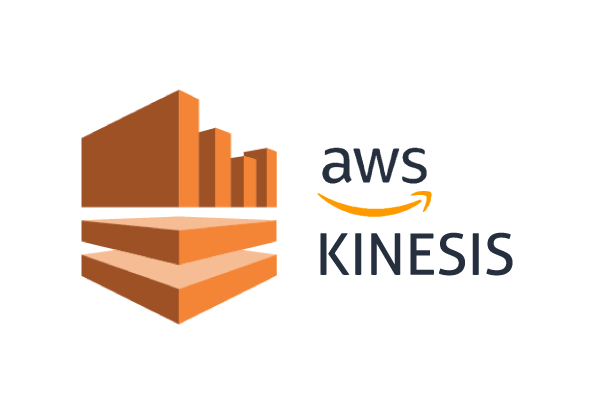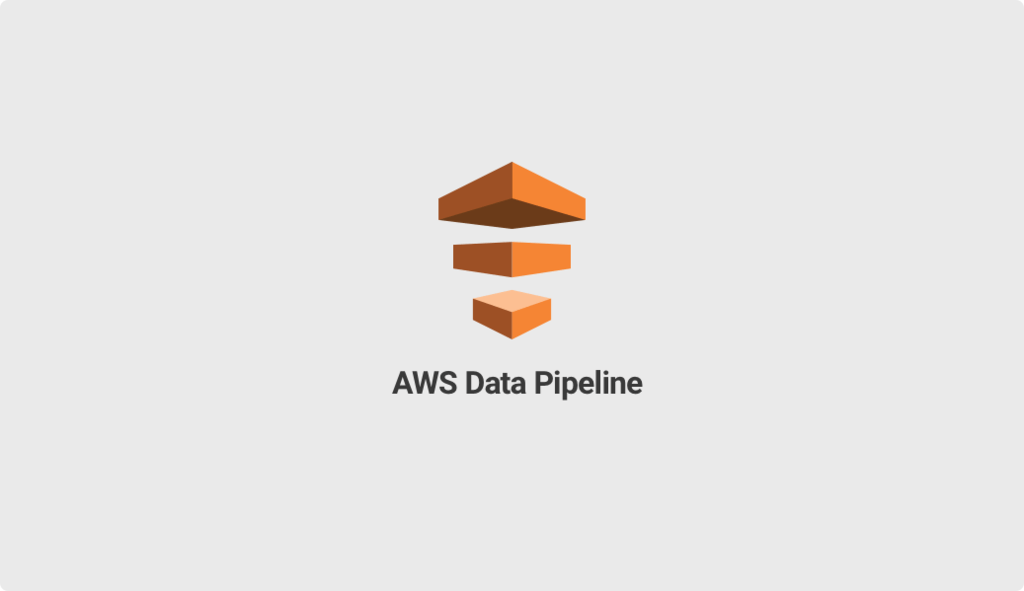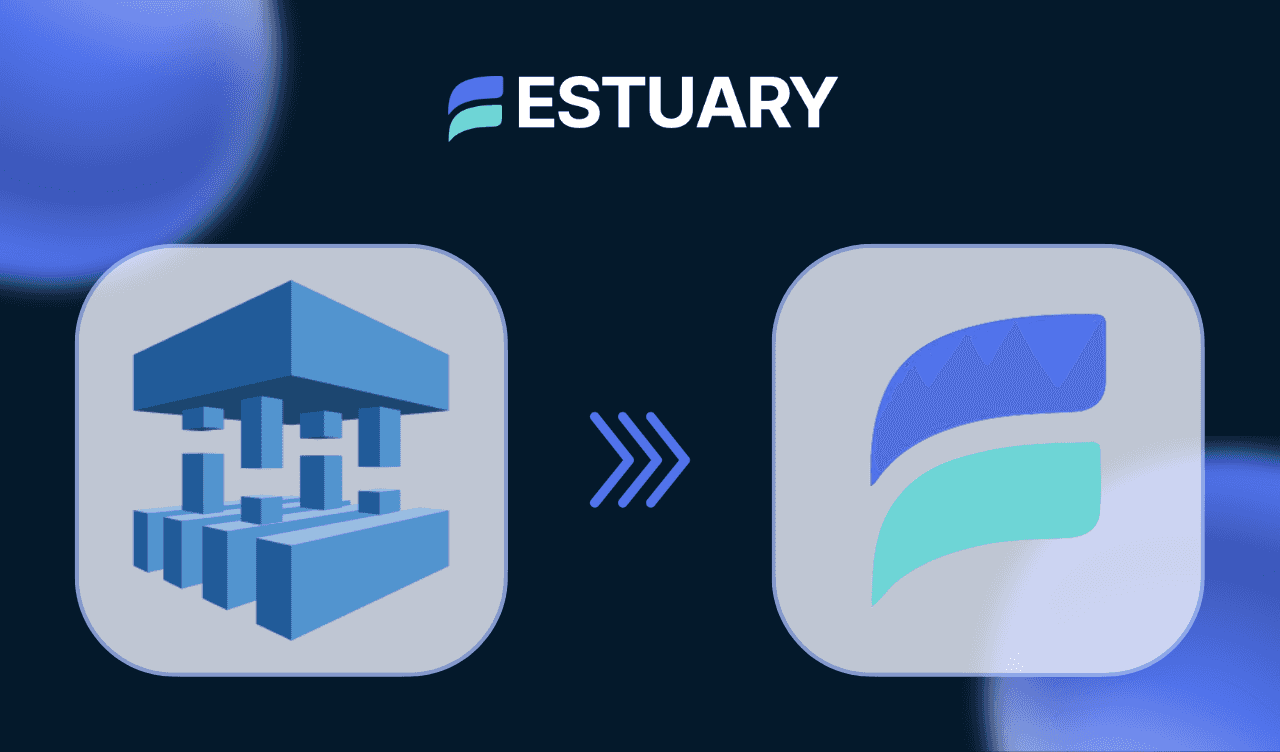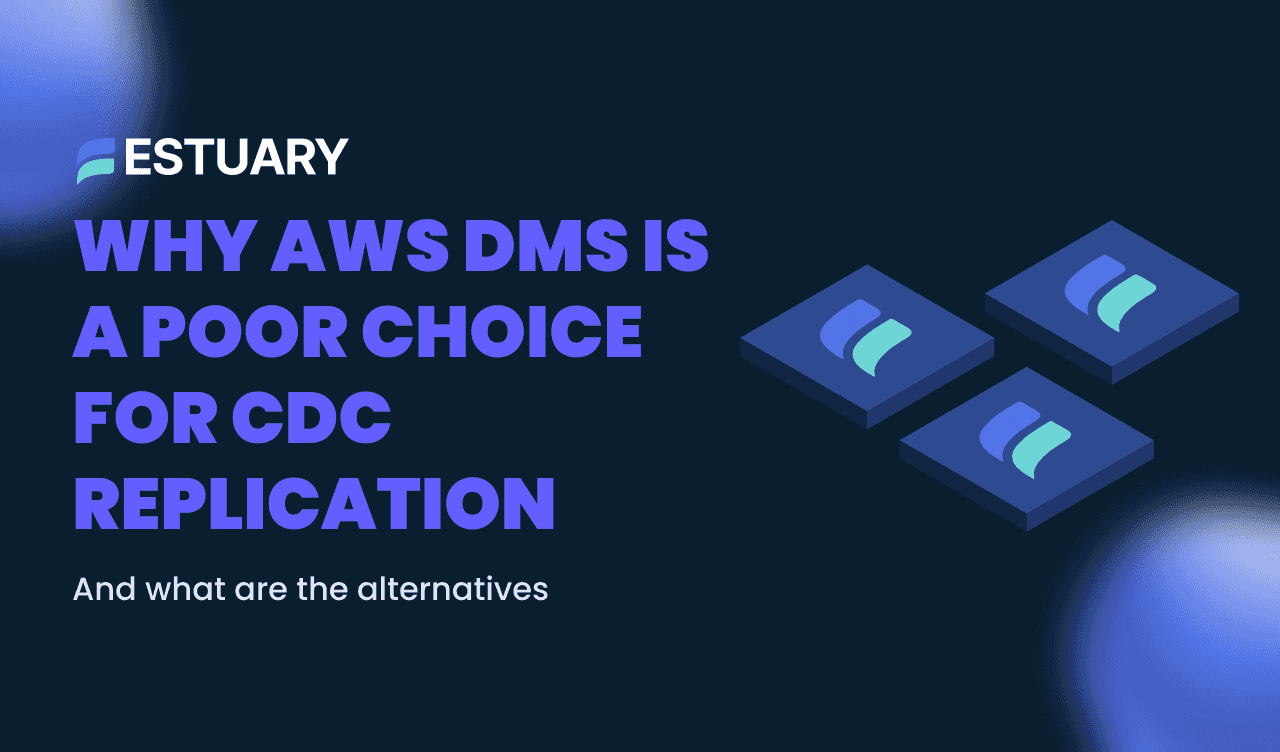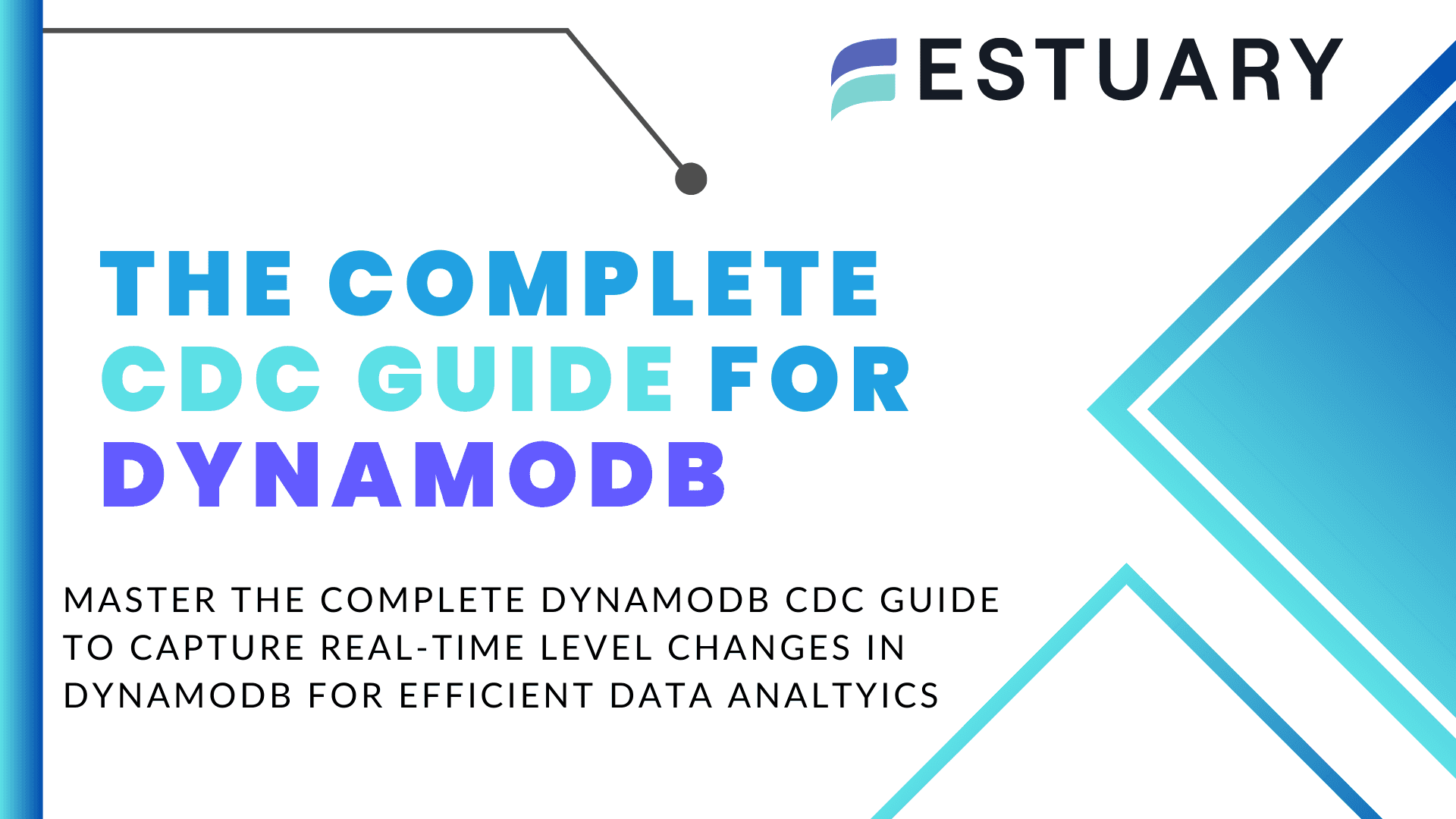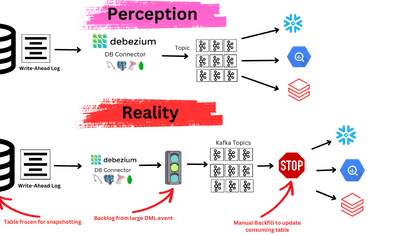
Modern businesses rely on fast, data-driven decisions, but managing diverse data across systems is complex and time-consuming. That’s where ETL (Extract, Transform, Load) tools come in. They help teams unify, transform, and load data into analytics-ready environments.
If you're building on Amazon Web Services (AWS), choosing the right ETL tool is critical. AWS offers native services like Glue, Lambda, and Kinesis, each with its strengths and trade-offs. But for many organizations, native tools introduce hidden complexity, cost, and limitations in real-time capabilities.
In this guide, we’ll explore the top AWS ETL tools in 2025 — including a smart alternative: Estuary Flow, a real-time, low-latency platform that streamlines data movement into AWS with simplicity and speed.
Whether you're building batch pipelines or modernizing toward real-time streaming, this comparison will help you pick the best solution for your data strategy.
What Are AWS ETL Tools?
AWS ETL tools help organizations extract data from various sources, transform it into a usable format, and load it into data lakes, warehouses, or analytics platforms — all within the Amazon Web Services ecosystem.
These tools simplify complex data workflows by handling the three core ETL stages:
- Extract: Pull data from databases, APIs, SaaS platforms, or flat files.
- Transform: Clean, enrich, standardize, or model data to make it analysis-ready.
- Load: Move transformed data into AWS destinations like Amazon Redshift, S3, DynamoDB, or others.
AWS ETL tools are built to handle large-scale workloads efficiently, making them essential for businesses that require timely, consistent, and scalable data pipelines for analytics, machine learning, and operational intelligence.
AWS ETL Tools: Comparison Table
To help you evaluate your options quickly, here’s a side-by-side comparison of major AWS ETL tools. We’ve broken down their real-time capabilities, use cases, cost complexity, scalability, and pre-built connector availability.
Tool | Real-Time Processing | Best Use Case | Processing Speed | Cost Complexity | Scalability | Pre-Built Connectors |
| AWS Glue | No | Batch ETL for big data pipelines | Medium | High | Auto-scales | AWS-focused |
| AWS Lambda | Yes | Event-driven ETL, microservices | Fast | Moderate | Auto-scales | AWS-only |
| AWS Kinesis | Yes | Real-time streaming analytics | Very Fast | High | Auto-scales | Limited |
| AWS Data Pipeline | No | Legacy batch ETL workflows | Slow | Moderate | Limited | Deprecated |
Note: As of July 2024, AWS Data Pipeline is deprecated for new users. Migration to other AWS tools or external platforms is recommended.
Top AWS ETL Tools
Here are the top four ETL tools in AWS that help streamline your business processes and enhance data management capabilities.
1. AWS Glue
AWS Glue is a fully managed ETL (Extract, Transform, Load) service provided by Amazon Web Services (AWS). It simplifies large-scale data processing by automating data discovery, cataloging, cleaning, and transformation workflows, thereby reducing the time and effort required for data preparation and integration. Glue is particularly effective for organizations seeking to build scalable data pipelines for analysis or business intelligence purposes.
Key Features of AWS Glue
- Serverless Environment: AWS Glue provides a fully serverless architecture, which means that the underlying infrastructure for ETL jobs is automatically provisioned and scaled based on the workload. This eliminates the need for manual management of infrastructure resources, which lets data engineers and data analysts focus on core business initiatives rather than maintaining and managing servers.
- Data Catalog: AWS Glue includes a built-in Data Catalog, which serves as a centralized metadata repository for storing and managing the schemas of your data assets. The Glue Data Catalog automatically crawls your data sources, infers schemas, and populates the catalog, making it easy for engineers and analysts alike to search and discover datasets.
- Pre-Built and Custom Transformations: AWS Glue offers a comprehensive library of pre-built transformations for common data preparation tasks such as filtering, aggregation, deduplication, and joins. These built-in transformations simplify the ETL process by providing ready-made functions that can be easily applied to datasets. In addition, AWS Glue allows you to write custom transformations using Python, Scala, or SQL scripts, enabling more complex and tailored data processing workflows.
- AWS Glue DataBrew: Glue DataBrew is a no-code visual data preparation tool that allows users to clean and transform data interactively without needing to write code. With DataBrew, you can perform tasks such as data profiling, normalization, and visualizing data lineage through a user-friendly interface, making interacting with data pipelines easy for less technical users.
Use Cases
AWS Glue is highly versatile and supports various ETL frameworks, including both ETL and ELT (Extract, Load, Transform) processes. It is suitable for:
- Batch processing of large datasets
- Integrations between data lakes and data warehouses, providing easy integration with Amazon S3, Amazon Redshift, Amazon Athena, and other AWS services.
Drawbacks
- Complex Pricing Model: AWS Glue pricing is based on Data Processing Units (DPUs), which can make it difficult to predict costs, especially for large-scale jobs with variable processing times.
- Lack of Real-Time Processing: Glue jobs can have a significant cold-start time, particularly for serverless Spark jobs. This latency can be problematic for workflows requiring near-real-time data processing.
- Limited Support for Non-AWS Data Sources: While Glue integrates well with other AWS services, it might not offer seamless or optimized connectivity with non-AWS data sources compared to other ETL tools.
2. AWS Lambda
AWS Lambda is a fully-managed, serverless computing service that allows you to run code in response to various events without the need for provisioning or managing servers. This makes Lambda particularly useful for real-time data processing and highly scalable workloads.
Key Features of AWS Lambda
- Serverless Architecture: AWS Lambda is serverless, automatically provisioning, scaling, and managing infrastructure to run code triggered by events like S3 changes, DynamoDB updates, or API Gateway requests. It scales dynamically based on demand, ensuring cost-efficiency and performance without manual intervention.
- Integration with AWS Services: Lambda integrates with services like S3, DynamoDB, and Kinesis to run custom logic in response to events, enabling real-time data processing and transformation. For example, it can perform ETL operations on Kinesis streams before sending the data to Redshift.
- Multi-Language Support: Lambda supports multiple languages, including Python, Java, Node.js, and more. Custom runtimes can be created using the AWS Lambda Runtime API, offering developers the flexibility to use their preferred languages.
- Function Versioning: Lambda allows function versioning, letting you create and manage multiple function versions. This makes it easier to test updates and rollback changes without impacting live applications.
Use Cases
- Reactive Data Pipelines: AWS Lambda is highly effective for transforming data streams in response to events before loading them into storage systems like Amazon DynamoDB or Amazon Redshift. For example, you can use Lambda to preprocess streaming data from Amazon Kinesis by cleaning, filtering, or enriching the data as it reacts to incoming events throughout the pipeline.
- Automated Task Scheduling and Orchestration: Lambda, in conjunction with Amazon CloudWatch Events, can automate a wide range of tasks, such as batch processing, report generation, and periodic data clean-up. For instance, you can schedule Lambda functions to run daily to archive old data, generate business reports, or trigger ETL pipelines.
Drawbacks
- Cold Start Latency: AWS Lambda can experience delays when a function is invoked after a period of inactivity due to the "cold start," which can introduce latency, particularly in low-latency or real-time applications.
- Execution Time Limit: Lambda functions have a maximum execution time of 15 minutes, making them unsuitable for long-running tasks or complex workflows that require extended processing times.
3. AWS Kinesis
Amazon Kinesis is a fully managed service that enables real-time processing of streaming data at any scale. Kinesis is ideal for applications that require continuous data ingestion and real-time analysis, such as log and event data monitoring, IoT data processing, and media streaming.
Components of AWS Kinesis
- Kinesis Data Streams: Allows you to capture, store, and process streaming data in real time. It can ingest massive volumes of data from sources like web applications, financial transactions, or IoT devices. You can process this data in real-time using consumer applications such as AWS Lambda, Apache Spark, or other streaming analytics platforms.
- Kinesis Video Streams: Designed for securely streaming and processing live video data from devices like security cameras, mobile devices, and IoT sensors. It is useful for building applications that require real-time video analysis, such as video analytics for surveillance, video conferencing, or smart home applications.
- Kinesis Data Firehose: A fully managed service for delivering streaming data to other AWS services, such as Amazon S3, Amazon Redshift, and Amazon Elasticsearch Service. It can automatically scale to match the throughput of incoming data, and it can batch, compress, and encrypt the data before delivering it to the specified destination.
Key Features of AWS Kinesis
- Scalability: Kinesis automatically scales to handle large volumes of streaming data, adapting to high throughput without manual intervention. This makes it ideal for applications with fluctuating data rates, such as mobile apps or IoT devices.
- Real-Time Analytics: Kinesis Data Analytics allows real-time analysis of streaming data using standard SQL queries, enabling immediate insights and data-driven decisions without complex code. It integrates with AWS services like Lambda and Redshift for more complex analytics workflows.
- Enhanced Fan-Out: Kinesis Data Streams' Enhanced Fan-Out enables multiple consumer applications to process the same stream concurrently, each with its own dedicated read throughput, improving efficiency and reducing latency.
Use Cases
- High-Throughput, Real-Time Data Streaming: Kinesis is ideal for applications requiring continuous, real-time ingestion and processing of large volumes of streaming data, such as log aggregation, clickstream data from websites, or IoT sensor data, where low-latency processing is crucial.
- Multiple Concurrent Consumers: Kinesis is better suited for scenarios where multiple applications need to consume and process the same stream simultaneously (e.g., analytics, monitoring, and alerting systems) due to its Enhanced Fan-Out feature, offering dedicated throughput for each consumer.
Drawbacks
- Pricing Complexity: Kinesis pricing can be difficult to predict due to charges based on shard hours, PUT payload units, data retention, and data transfer, which can lead to unexpected costs, especially for high-throughput applications.
- Shard Management Overhead: While Kinesis scales automatically, managing shards (the basic unit of capacity) manually can be complex, requiring careful tuning to avoid bottlenecks or over-provisioning for consistent performance.
- Limited Data Retention: By default, Kinesis Data Streams retain data for only 24 hours (extendable to 7 days), which may not be sufficient for applications requiring longer retention without additional storage solutions.
4. AWS Data Pipeline
Note: As of July 25th, 2024, AWS Data Pipeline is no longer available to new users. Existing users can continue to use the platform and should be considering a migration. If you’re a current AWS Data Pipeline user, continue through this article to learn about alternatives and how they compare to AWS Data Pipeline.
AWS Data Pipeline is a web service that automates the movement and transformation of data across various AWS services and on-premises data sources. It enables you to create, schedule, and manage complex data workflows, ensuring that data is efficiently processed, integrated, and moved between different locations.
Key Features of AWS Data Pipeline
- Visual Interface: AWS Data Pipeline provides a visual drag-and-drop interface that simplifies the creation of data workflows. Using the Pipeline Designer, you can easily configure data sources, transformations, and destinations on a visual canvas. This interface allows users to define the flow of data between different services such as Amazon S3, Amazon RDS, DynamoDB, and on-premise systems.
- Customizable Alerts: To enhance workflow monitoring, AWS Data Pipeline offers customizable notifications and alerts. These notifications can be triggered based on specific events, such as successful completion, failures, or delays in the pipeline execution. Alerts can be integrated with Amazon SNS (Simple Notification Service) to send real-time notifications via email, SMS, or other channels, enabling you to react immediately when events occur in your data workflow.
- Security: AWS Data Pipeline integrates with AWS Identity and Access Management (IAM) to define granular access controls over your data workflows. It supports data encryption both at rest and in transit, ensuring that sensitive data is protected throughout the pipeline. You can also assign IAM roles to pipelines, allowing them to access necessary AWS services securely without exposing long-term credentials.
Use Cases
AWS Data Pipeline is an effective tool for orchestrating data movement between different AWS services and external systems. It supports a wide range of data integration tasks, such as:
- On-Premises Data Integration: AWS Data Pipeline supports seamless integration with on-premises data sources and services, making it ideal for hybrid environments where data resides outside of AWS.
- Complex Scheduling and Orchestration: If you need more advanced scheduling options or dependency management between tasks, Data Pipeline offers more flexibility for custom workflows and coordinating different data sources
- Custom or Non-Spark Workflows: If you need to run non-Spark jobs or custom scripts across different environments, Data Pipeline is better suited as Glue focuses on serverless Spark ETL jobs.
Drawbacks
- Manual Resource Management: AWS Data Pipeline often requires users to provision and manage underlying resources, like EC2 instances or EMR clusters, which adds complexity and can lead to higher operational overhead compared to fully serverless solutions.
- Limited Scalability and Flexibility: Compared to newer tools like AWS Glue, Data Pipeline doesn't scale as easily for large-scale data processing or provide as much flexibility for handling complex data transformations.
- Outdated Interface and Less Automation: The user interface is less intuitive, and it lacks some automation features found in modern data orchestration tools, which can make creating and managing data workflows more cumbersome.
Drawbacks of Native AWS ETL Tools
While AWS ETL tools offer powerful capabilities, they also come with some limitations that businesses should consider when choosing an ETL platform.
- Limited Source Connectors: AWS provides a wide array of pre-built connectors to integrate with various services, but these may not cover every potential use case. For more specialized integrations, organizations may need to invest in additional development work, which can complicate workflows and increase costs. This is particularly relevant for integrating data from non-AWS platforms or legacy systems.
- Vendor Lock-In: Relying heavily on AWS services for ETL pipelines can create a strong dependency on their ecosystem, making it difficult to migrate or integrate with non-AWS platforms down the road. Over time, switching to alternate providers can become very costly and complex, reducing your freedom to choose the best tools for your evolving business needs.
- Steep Learning Curve: Services like AWS Glue, AWS Kinesis, and AWS Lambda offer advanced features, but their complexity can present a steep learning curve, particularly for new users or teams unfamiliar with the AWS ecosystem. Mastery of these tools (and cost estimation for them!) often requires significant training and a deep understanding of AWS's broader architecture, making it more challenging for businesses without prior AWS experience to effectively implement these tools.
- Cost Estimation Challenges: AWS ETL tools have complex pricing models that make it difficult for organizations to accurately predict expenses. The multitude of variables—such as data processing units, storage tiers, data transfer costs, and varying rates for different services and regions—can lead to unforeseen charges. This complexity hampers effective budgeting and financial planning, as estimating the total cost of ownership becomes a challenging task, especially when scaling operations or dealing with fluctuating workloads.
In short: Native AWS ETL tools work well within their ecosystem, but fall short when you need faster onboarding, cross-cloud flexibility, or real-time performance at scale.
While AWS offers powerful tools for building ETL pipelines, many organizations find these solutions difficult to scale, integrate, and maintain, especially when working with real-time or cross-cloud data.
That’s where Estuary Flow comes in. It's a cloud-native platform built to eliminate the friction of traditional ETL on AWS, with real-time streaming, schema evolution, and no-code pipeline creation that works across your entire data stack.
Estuary Flow: A Real-Time Alternative to Native AWS ETL Tools
While AWS provides powerful ETL tools like Glue, Lambda, and Kinesis, these often come with complex pricing, steep learning curves, and limited real-time flexibility. That’s where Estuary Flow stands out — as a modern, real-time-first platform that simplifies AWS data pipelines without sacrificing performance or scalability.
Estuary Flow is a fully managed data movement and transformation platform built for both batch and streaming workloads. Unlike traditional AWS tools that often require stitching services together, Flow provides an all-in-one, no-code interface to build pipelines in minutes, and it’s especially well-suited for integrating with Amazon Redshift, S3, DynamoDB, Kinesis, Aurora, and more.
Why Use Estuary Flow with AWS?
- Real-Time CDC & Streaming: Instantly sync changes from sources like PostgreSQL, Oracle, MongoDB, or DynamoDB to AWS destinations such as S3 or Redshift. No lag, no polling—just streaming data, always up to date.
- No-Code + Developer-Friendly: Use an intuitive UI to design pipelines, or apply transformations using SQL and TypeScript. Great for teams of all technical skill levels.
- 200+ Connectors (AWS & Beyond): Flow includes native connectors for Amazon S3, Kinesis, DynamoDB, Redshift, SQS, DocumentDB, and more — plus dozens of SaaS and database platforms outside AWS.
- Private Cloud Deployments for Security & Compliance: Need complete control over your infrastructure? Estuary offers Private Deployment and Bring Your Own Cloud (BYOC) options, ideal for enterprises with strict governance requirements.
- Automatic Schema Evolution: Flow detects and adapts to schema changes, reducing the risk of pipeline breakage when upstream data evolves.
- Transparent, Usage-Based Pricing: Unlike Glue or Kinesis, which have multi-variable and hard-to-predict pricing models, Estuary charges simply based on data throughput (GB). No surprise bills, no overages.
When to Choose Estuary Flow over AWS ETL Tools
Use Case | AWS Native Tools | Estuary Flow |
| Real-time data sync across systems | Limited (e.g., Kinesis only) | Built-in CDC connectors |
| Cross-cloud or hybrid integrations | Complex setup | Supports 200+ sources/destinations |
| Schema drift handling | Manual effort | Auto schema evolution |
| No-code interface | Minimal | Full no-code + CLI support |
| Transparent pricing | Complex & unpredictable | Simple GB-based pricing |
| Security and private hosting | Limited to AWS | BYOC & Private Deployments |
Real-World Example: DynamoDB to Redshift in Minutes
With Estuary Flow, you can set up a real-time pipeline from Amazon DynamoDB to Amazon Redshift in just a few clicks. Flow captures inserts, updates, and deletes from DynamoDB using change data capture (CDC) and streams them into Redshift — automatically handling schema mapping and backfills.
Try Estuary Flow Today
Skip the manual configuration and AWS stitching. Estuary Flow helps you build modern, scalable ETL pipelines in minutes — no glue code, no surprises.
Sign up for free or join our Slack community to start building your real-time AWS data pipelines.
Conclusion: Choose the Right AWS ETL Tool for the Future
The right ETL tool can make or break your data strategy on AWS. While native options like AWS Glue, Lambda, and Kinesis offer powerful capabilities, they also bring hidden complexity, limited real-time capabilities, and cost unpredictability.
If your team is looking for a faster, easier, and more flexible way to move data within or into the AWS ecosystem, Estuary Flow is a strong alternative. With real-time streaming, automatic schema evolution, and a no-code interface, it empowers your team to build resilient, scalable pipelines without the heavy DevOps lift.
Whether you're syncing S3 buckets, ingesting IoT streams into Redshift, or modernizing your legacy ETL workflows, Estuary Flow simplifies the entire process with unmatched speed and clarity.
Also Read:
FAQs
1. Which AWS ETL tool is best for beginners?
2. How much do AWS ETL tools cost?
3. What’s the easiest way to move data from on-prem to AWS?

About the author
Dani is a data professional with a rich background in data engineering and real-time data platforms. At Estuary, Daniel focuses on promoting cutting-edge streaming solutions, helping to bridge the gap between technical innovation and developer adoption. With deep expertise in cloud-native and streaming technologies, Dani has successfully supported startups and enterprises in building robust data solutions.

